The Seagate IronWolf 110 SSD, though announced at CES back in January, only recently hit the market at the end of April. The IronWolf 110 SSD is an edition to Seagate’s enterprise-class drives, promising accelerated reads and writes through Seagate’s exclusive Durawrite technology, which also is said to extend the life of the flash. But let’s not go too far into this without acknowledging the fact that Seagate has launched an SSD specific to the NAS use case, an industry first. If nothing else this gives more credence, as if there wasn’t enough prior, that the performance profile of flash is wanted in just about every use case possible, so long as cost, durability and capacity meet customer’s needs. The last one is an interesting point. While HDDs have hit the 14TB water mark, SSDs are far too costly to go into NAS workloads at that capacity. What flash unlocks however, is the ability to enable deduplication, compression and erasure coding to net effective capacities of 4:1 or more, depending on workload. So the top capacity Ironwolf 110 SSD, could really come out at nearly 12TB effective in the right environment.
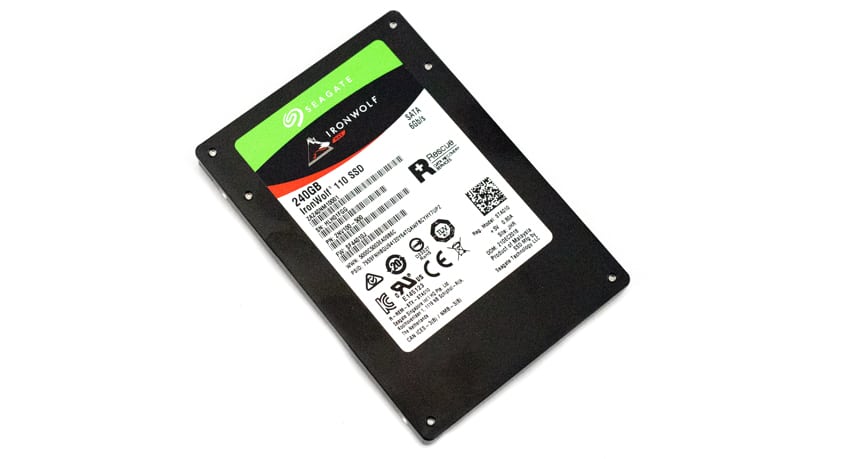
Not all NAS providers are there yet however, and most NAS owners don’t need them to be loaded with flash at this point. What they can do however is add an SSD or two to take advantage of caching and or tiering capabilities all major NAS vendors offer today. Because the IronWolf 110 SSD uses a SATA interface, it’s also a lower cost option than SAS or NVMe based offerings that while faster, are a little harder to take full advantage of in a NAS. Just because it’s SATA though doesn’t mean it’s light weight; Seagate has based this on their Nytro line of enterprise SSDs, which is important to note. They didn’t just trade labels with one of their end user computing drives, which is why the endurance and performance profile of the IronWolf 110 SSD are appropriate for this class of workload. Additionally the drives will offer support for IronWolf Health Management and they come with two years of rescue data recovery services.
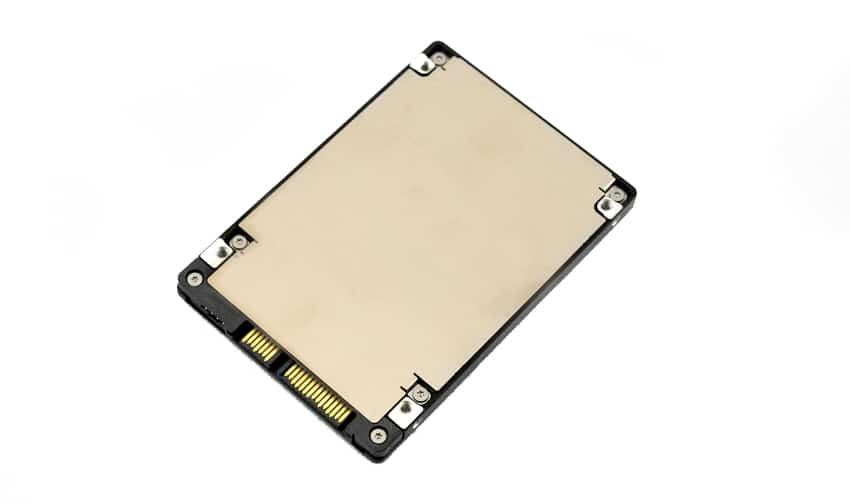
Looking at performance, Seagate quotes maximum performance of up to 560MB/s read and 535MB/s write, and throughput up to 85,000 IOPS read and 60,000 IOPS write for the 3.84TB capacity drive. On the topic of capacity, the IronWolf 110 is available in 3.84TB, 1.92TB, 960GB, 480GB, and 240GB capacities. From an endurance perspective, the 3.84TB drive offers an endurance rating of 7000TBW, scaling down to 438TBW for the 240GB drive. All of the IronWolf 110 SSDs are backed by a 5-year limited warranty.
Seagate IronWolf 110 SSD Specifications
| Capacity | 3.84TB, 1.92TB, 960GB, 480GB, 240GB |
| Interface | SATA 6Gb/s |
| NAND Flash Type | 3D TLC |
| Form Factor | 2.5 in x 7mm |
| Performance | Sequential Read 128KB: 560MB/s Sequential Write 128KB: 535MB/s; 345MB/s Random Read 4KB: 85K IOPS; 55K IOPS Random Write 4KB: 45K IOPS; 30K IOPS |
| Endurance | Total Bytes Written (TB): 7,000; 435 Nonrecoverable Read Errors per Bits Read: 1 per 10E17 MTBF: 2,000,000 Limited Warranty: 5 years |
| Power Management | +5/+12V Active Max Average Power(W): 3.5; 2.3 Average Idle Power (W): 1.2; 1.1 |
| Environmental | Temperature, Operating Internal: 0oC – 70oC Temperature, Nonoperating: -40oC – -85oC Temperature Change Rate/Hr, Max:20oC Shock, 0.5ms (Gs):1000 |
| Physical | Height:7.0mm/0.276in Width: 70.10mm/2.760in Depth: 100.25mm/3.947in Weight: 77g/0.169lbs |
Seagate IronWolf 110 SSD Review Configuration
In this review, we take a bit of a different approach in our testing. For the IronWolf 110 240GB SSDs, we use our NETGEAR ReadyNas 628X for testing and comparing the data to the Seagate IronWolf and IronWolf Pro 14TB HDD’s. Obviously there is a big difference in capacity here, but the primary focus is to compare the pros and cons of using flash in a NAS. We will be looking at 8 samples of the 240GB SSDs, which we configured in RAID 6. We use our Dell PowerEdge R730 with a Windows S2012 R2 VM as a load generator.
Seagate IronWolf 110 SSD Performance
Enterprise Synthetic Workload Analysis
Our enterprise hard drive benchmark process (which we will be using for the 240GB SSDs in this review) preconditions each drive-set into steady-state with the same workload the device will be tested with under a heavy load of 16 threads, with an outstanding queue of 16 per thread. The device is then tested in set intervals in multiple thread/queue depth profiles to show performance under light and heavy usage. Since hard drives reach their rated performance level very quickly, we only graph out the main sections of each test.
Preconditioning and Primary Steady-State Tests:
- Throughput (Read+Write IOPS Aggregate)
- Average Latency (Read+Write Latency Averaged Together)
- Max Latency (Peak Read or Write Latency)
- Latency Standard Deviation (Read+Write Standard Deviation Averaged Together)
Our Enterprise Synthetic Workload Analysis includes four profiles based on real-world tasks. These profiles have been developed to make it easier to compare to our past benchmarks, as well as widely-published values such as max 4K read and write speed and 8K 70/30, which is commonly used for enterprise drives.
- 4K
- 100% Read or 100% Write
- 100% 4K
- 8K 70/30
- 70% Read, 30% Write
- 100% 8K
- 128K (Sequential)
- 100% Read or 100% Write
- 100% 128K
In our throughput test measuring 4K random performance, the Seagate IronWolf 110 SSD outshone the HDD’s by a large margin in both CIFS and iSCSI, posting an iSCSI read/write performance of 25,175 IOPS and 22,284 IOPS, and a CIFS read/write performance of 58,936 IOPS and 19,796 IOPS, respectively.
In 4K average latency, the IronWolf 110 SSD took the lead in both tests, showing 4.34ms read and 12.93ms write in CIFS, and 10.17ms read and 11.49ms write in iSCSI.
Looking at max 4k latency, we see the IronWolf 110 SSD showed much better performance in CIFS than in iSCSI. In CIFS, we see a latency of 3.57ms read and 40.98ms write. With iSCSI, we see a latency of 225.26ms read and 891.21 write.
In the last bit of our 4K tests, we look at standard deviation. Here, the IronWolf 110 SSD managed to fall behind the IronWolf Pro 14TB HDD in CIFS write, but excelled in all other tests. Looking at CIFS, we see reads at 23.6ms and writes at 680.39ma (falling behind the Pro’s 414.62ms). Looking at iSCSI, we see reads at 12.03ms and writes at 51.64ms.
The next benchmark tests the drives under 100% read/write activity, but this time at 8K sequential throughput. The Seagate IronWolf and IronWolf PRO HDDs went neck-to-neck with the SSDs in this test, outperforming them in CIFS read/write, but falling behind in iSCSI. Looking at CIFS, the 110 SSD showed read speeds at 70,555 IOPS and write speeds at 42,589 IOPS, while iSCSI had performance figures at 201,130 IOPS read and 62,596 IOPS write.
Our next test shifts focus from a pure 8K sequential 100% read/write scenario to a mixed 8K 70/30 workload, where we will show how performance scales in a setting from 2T/2Q up to 16T/16Q. The IronWolf 110 SSD showed consistent increases in performance in both iSCSI and CIFS, with IOPS in the terminal queue depth at 20,221 and 24,889, respectively.
The 8K 70/30 average latency charts show a slight increase throughout the tests, with the 110 SSD kicking off CIFS and iSCSI at 0.38ms and 0.37ms, and ending with 10.28ms and 12.65ms, respectively.
In maximum latency, the 110 SSD showed a range of 125.6ms and 444.87ms, and 271ms and 429.99ms in CIFS and iSCSI, respectively.
Standard deviation for 8K 70/30 showed the 110 SSD with 1.06ms to 15.8ms in CIFS and 0.98ms to 21.3ms in iSCSI.
Our last test for the 240GB SSDs is the 128k benchmark, which is a large-block sequential test that shows the highest sequential transfer speed. Here, the 110 SSD was outdone by both HDD’s in CIFS and iSCSI writes, and the Pro in iSCSI reads.
Conclusion
The Seagate IronWolf 110 SSD is a duty specific SSD designed for all-flash and tiering/caching enabled NAS use cases. The IronWolf 110 leverages Seagate’s DuraWrite technology which, in addition to performance enhancements, prolongs the life of the SSD. The drive also sports a power loss data protection circuit, enterprise-class in-house SSD controller, and a SATA 6Gb/s interface for easy deployment. Capacities of the SSD range from 240GB to 3.84TB and come with a 5-year limited warranty and 2 years of data recovery services.
In this review, we looked at the 240GB drive; leveraging eight 240GB SSDs in our NETGEAR ReadyNas 628X. We compared them to the IronWolf and IronWolf Pro 14TB HDDs to highlight the pros and cons of using flash in a NAS. Some highlights include 4K throughput of 58K IOPS (CIFS) read, 22K IOPS write (iSCSI), with average latencies as low as 4.34ms read (CIFS) and 11.49ms write (iSCSI). 8K 100% read/write throughput saw 201K IOPS read and 63K IOPS write in iSCSI but only 71K IOPS read and 43K IOPS write in CIFS. In large block transfer speeds we saw CIFS performance of 2.3GB/s read and 913MB/s write and iSCSI performance of 1.78GB/s read and 1.02GB/s write. The conclusion here being that the SSD is great for random workloads (where performance figures excelled), but when considering sequential workloads, the HDDs are still preferable. To get the best of both worlds, some NAS vendors have an option for hybrid configurations that allow sequential workloads to pass through the flash layer, going straight to HDDs.
The Seagate IronWolf 110 SSD is a NAS-specific offering for those that need higher-performing transactional performance in a cost-effective package. In the NAS world a little bit of flash can go a long way; adding a couple drives to enable caching and tiering is a great way to get more out of an investment in NAS hardware.


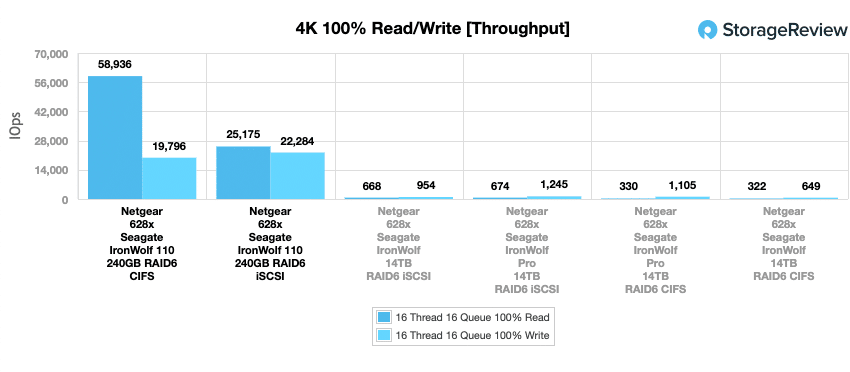
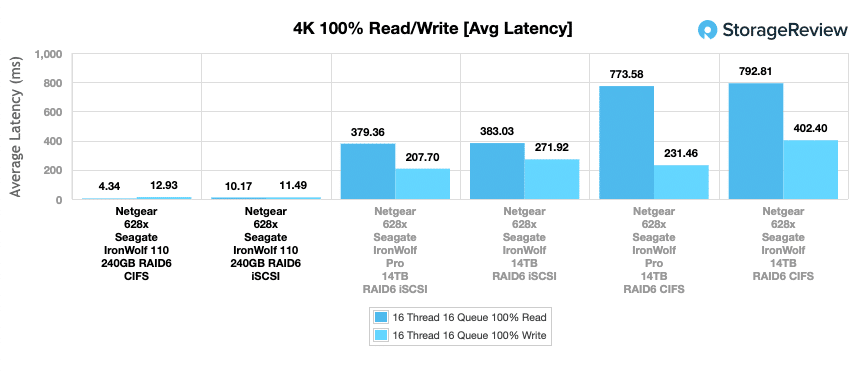
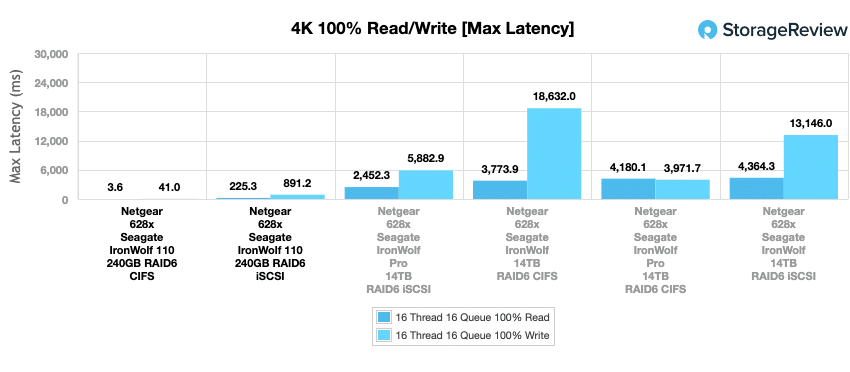
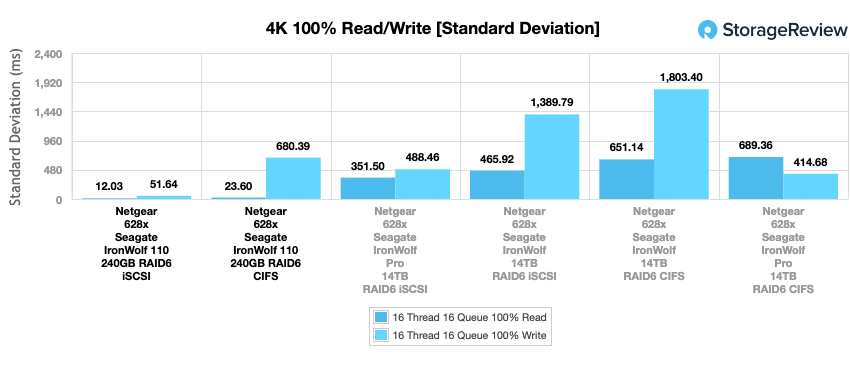
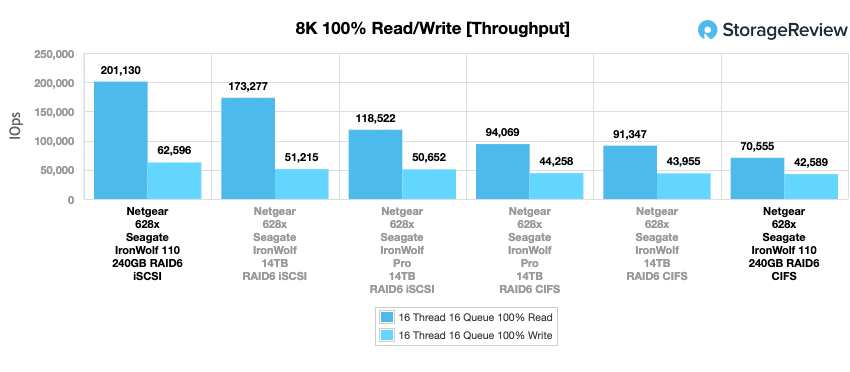
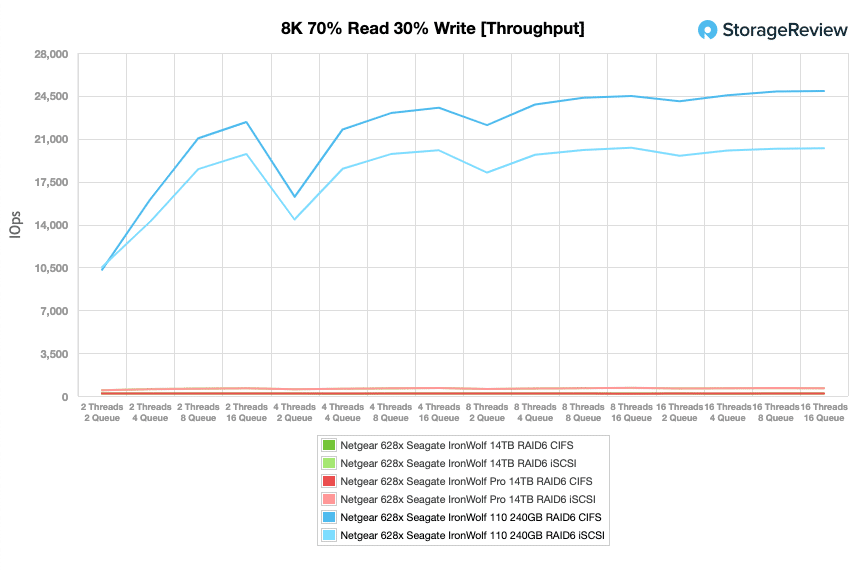
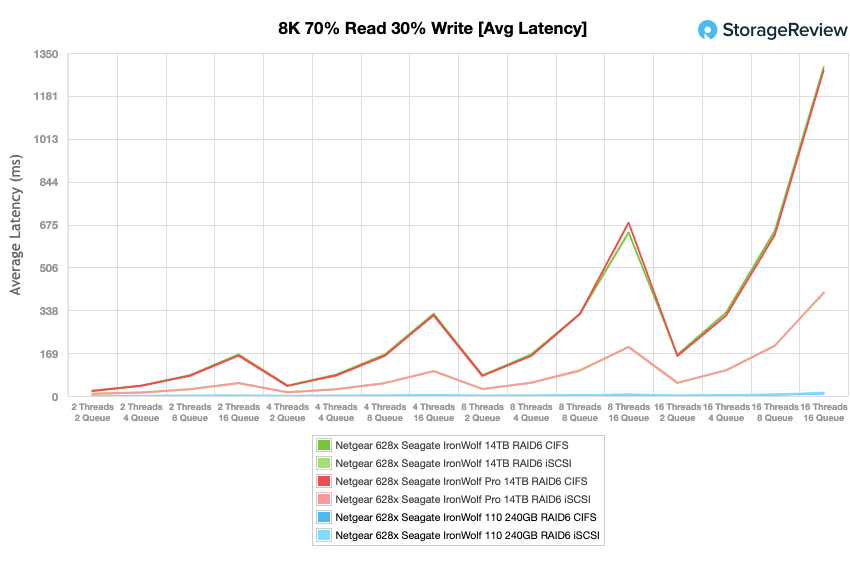
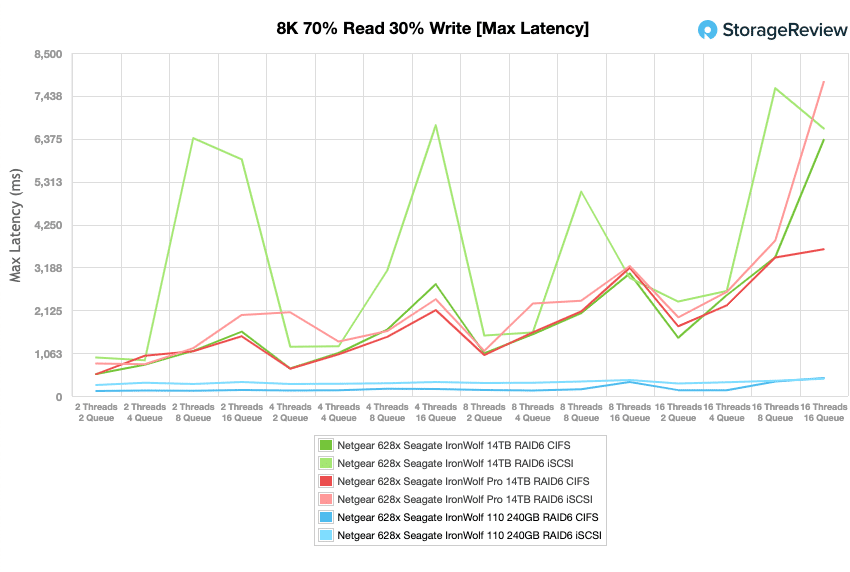
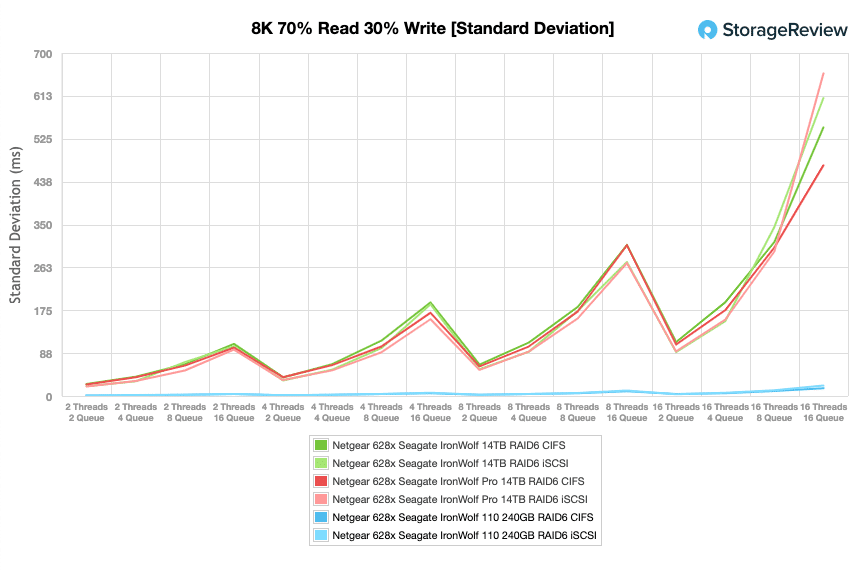
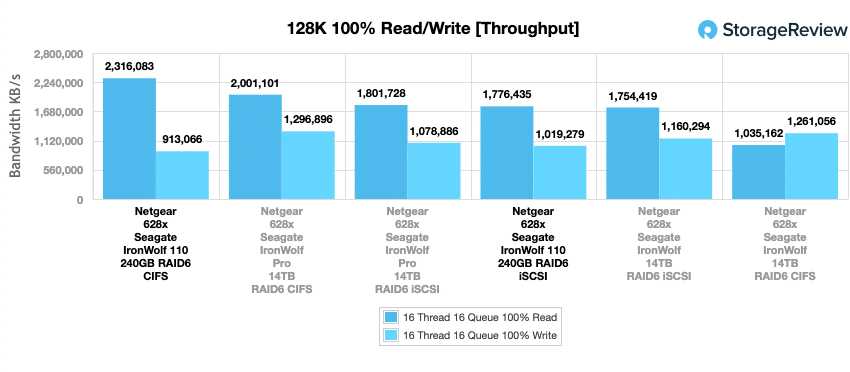


 Amazon
Amazon